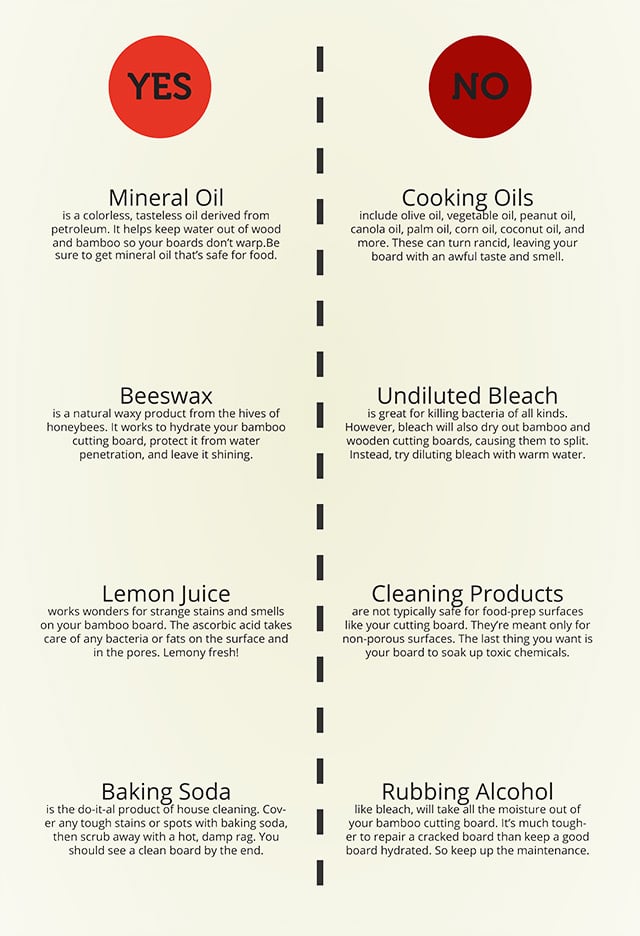A bamboo cutting board can be a beautiful and functional addition to your kitchen. It’s eco-friendly, durable, and gentle on your knives.
But to keep it in top condition, it requires a little care and attention. Neglecting your bamboo cutting board can lead to unpleasant odors, stains, and even warping. You might be wondering how to clean and maintain it without spending hours scrubbing or investing in expensive products.
Well, you’re in the right place! In this guide, you’ll discover simple, effective tips that make caring for your bamboo cutting board a breeze. Whether you’re a seasoned chef or a cooking novice, these practical steps will help ensure your board stays pristine and lasts for years. Dive in and unlock the secrets to preserving your bamboo cutting board’s natural beauty and functionality.

Credit: totallybamboo.com
Benefits Of Bamboo Cutting Boards
Bamboo cutting boards offer unique benefits for your kitchen. They are not only durable but also eco-friendly. These boards have gained popularity for several reasons.
Durability And Longevity
Bamboo is a strong material. It resists cuts and marks better than other woods. This makes bamboo boards last longer in your kitchen.
Eco-friendly Choice
Bamboo is a renewable resource. It grows quickly and needs less water. Choosing bamboo helps the environment.
Gentle On Knives
Bamboo cutting boards are gentle on knives. They prevent dulling of blades. This helps maintain your knives’ sharpness.
Natural Antibacterial Properties
Bamboo has natural antibacterial properties. This makes it a hygienic choice. It helps in keeping your food safe.
Lightweight And Easy To Handle
Bamboo cutting boards are lightweight. They are easy to move and store. This makes them convenient for everyday use.
Initial Cleaning After Purchase
Buying a bamboo cutting board is a great choice for any kitchen. Bamboo is durable, eco-friendly, and naturally resistant to bacteria. Yet, to enjoy its benefits, proper care is essential. Initial cleaning after purchase is the first crucial step. This process ensures your cutting board is ready for safe food preparation. Proper cleaning also extends the board’s lifespan. Let’s explore the steps for initial cleaning.
Initial Rinse
Rinse your bamboo cutting board under warm water. Avoid soaking it in water. This prevents warping and cracking. Use a soft sponge for gentle cleaning. This helps remove dust and debris from the surface.
Use Mild Soap
Choose a mild dish soap for cleaning. Avoid harsh chemicals or bleach. Apply a small amount of soap on the sponge. Gently scrub the board’s surface with the soapy sponge. Pay attention to the edges and corners.
Rinse Thoroughly
Rinse the cutting board thoroughly after scrubbing. Ensure all soap residues are removed. Soap residue can affect food taste and safety. Use warm water for a complete rinse.
Dry Immediately
Pat the board dry with a clean towel. Standing water can damage bamboo. Place the board upright to air dry. Ensure it is completely dry before storing.
Condition The Board
Apply food-grade mineral oil to the board’s surface. Use a soft cloth for application. Mineral oil helps maintain the board’s moisture. Let it absorb for a few hours or overnight. Wipe off excess oil before use.
Daily Cleaning Routine
Maintaining a bamboo cutting board is crucial for its longevity and hygiene. A daily cleaning routine ensures your board remains free from bacteria and retains its beautiful finish. Let’s explore how to effectively clean your bamboo cutting board every day.
Warm Water And Soap
Start with warm water and mild dish soap. Use a sponge or soft cloth to gently scrub the surface. This removes food particles and prevents stains. Rinse thoroughly with clean water to eliminate soap residue.
Avoiding Dishwasher Use
Never place your bamboo cutting board in the dishwasher. The high heat and moisture can warp the wood. Handwashing is safer and preserves the board’s natural oils. Dry it with a towel immediately after washing.

Credit: www.amazon.com
Deep Cleaning Techniques
Cleaning a bamboo cutting board starts with washing it with warm, soapy water. Dry it immediately to prevent warping. To maintain its shine, rub mineral oil on the surface monthly.
Maintaining your bamboo cutting board in pristine condition requires periodic deep cleaning. Everyday washing might not be enough to prevent stains, odors, and bacteria build-up. Deep cleaning not only preserves the board’s appearance but also prolongs its lifespan. Dive into these effective techniques to keep your bamboo cutting board fresh and hygienic. ###Using Vinegar Solutions
Vinegar is a fantastic natural cleaner. It disinfects and deodorizes your cutting board effectively. Mix equal parts of white vinegar and water in a spray bottle. Spray the solution generously over the board. Allow it to sit for a few minutes to tackle stubborn stains and bacteria. Rinse the board thoroughly with warm water. Pat it dry with a clean cloth. This simple method helps maintain the bamboo’s natural beauty and cleanliness. Have you ever noticed how vinegar leaves a fresh scent behind? ###Baking Soda Paste Method
Baking soda is another household staple that works wonders for deep cleaning. Create a thick paste by mixing baking soda with a little water. Spread this paste over the cutting board’s surface. Focus on areas with visible stains or odors. Let the paste sit for about 5-10 minutes. Scrub gently with a soft brush in circular motions. Rinse with warm water and dry with a towel. This method not only cleans but also neutralizes odors. Have you tried this method and noticed how smooth the board feels afterward? Regular deep cleaning using these methods ensures that your bamboo cutting board remains a healthy and safe tool in your kitchen. Which technique are you excited to try first?Removing Stains And Odors
Clean a bamboo cutting board with warm water and mild soap to keep it fresh. Remove stains using baking soda and lemon juice. Maintain the board’s quality by oiling it regularly with mineral oil, preventing odors and extending its life.
Cleaning and maintaining your bamboo cutting board can sometimes feel like a chore, but it’s essential for ensuring longevity and hygiene. Removing stains and odors from your board is a crucial part of this process. You might wonder if those stubborn marks and lingering smells can truly disappear. With the right techniques, they can. Let’s explore two effective methods that you can easily try at home.Lemon Juice Application
Lemon juice is more than just a zesty addition to your recipes. It’s a natural stain remover and deodorizer. Start by cutting a lemon in half. Squeeze the juice directly onto the stained or odorous areas of your cutting board. The citric acid in lemons works wonders on stains and neutralizes odors. Let it sit for a few minutes, then wipe with a clean cloth. Have you ever noticed how lemon juice refreshes not just your dishes, but also your kitchen tools? It’s like giving your cutting board a spa treatment!Salt Scrub For Stubborn Stains
Sometimes stains just won’t budge, no matter how much lemon juice you use. That’s where a salt scrub comes in handy. Sprinkle coarse salt generously over the stained area of your cutting board. The abrasive nature of salt helps lift those tough stains. Use a damp cloth or sponge to scrub the area. The friction will aid in breaking down the stain particles. Have you tried using salt in your cleaning routine before? It’s surprising how something so simple can be so effective. So, next time you’re battling with stains, give these methods a try. You’ll be amazed at how fresh and clean your bamboo cutting board can be with just a little effort. What will you do with the time saved from less scrubbing? Maybe cook a delicious meal that uses your fresh, clean cutting board!
Credit: totallybamboo.com
Regular Oil Treatment
Regular oil treatment keeps bamboo cutting boards clean and fresh. Apply food-safe oil to prevent cracks and dryness. Bamboo retains its smooth surface and lasts longer with routine care.
Regular oil treatment keeps bamboo cutting boards durable and looking fresh. Bamboo is porous, absorbing moisture and odors easily. Oil treatment adds a protective layer, preventing damage. It helps maintain the board’s natural shine and ensures longevity. Regular care with oil keeps your cutting board in top condition.Choosing The Right Oil
Select food-grade mineral oil for bamboo cutting boards. It’s safe and effective. Avoid vegetable or olive oils. They can spoil and cause odors. Beeswax is another good choice. It offers extra protection. Natural oils like coconut oil work too. Ensure they are refined and don’t leave a scent.How To Apply Oil
Clean the board first. Use warm water and mild soap. Dry it completely with a towel. Pour a small amount of oil onto the board. Use a clean cloth to spread the oil evenly. Rub in circles for thorough coverage. Let the oil soak in for a few hours. Wipe off any excess with a dry cloth. Repeat monthly to keep the board in great shape.Preventing Mold And Mildew
Bamboo cutting boards can develop mold and mildew if not maintained well. Moisture trapped in the board creates a perfect environment for these to grow. Regular cleaning and correct drying prevent this problem. Let’s explore some effective methods to keep your bamboo cutting board in top shape.
Ensuring Proper Drying
After washing, dry your bamboo cutting board immediately. Use a clean towel to remove surface water. Always dry the board standing upright. This position allows air to circulate around it. Proper air circulation speeds up drying. Never leave it flat on a wet surface. Moisture can seep in and promote mold growth.
Storage Tips
Store your bamboo cutting board in a dry, ventilated space. Avoid damp cabinets or drawers. Choose a spot with good air flow. Air helps keep the board dry and fresh. Consider hanging the board on a wall. This position ensures it stays dry and reduces mold risks.
Repairing Minor Damage
Gently scrub your bamboo cutting board with warm, soapy water to remove food residues. Dry immediately with a clean towel to prevent warping. Regular oiling keeps the board smooth and hydrated, minimizing minor damages and cracks.
Repairing minor damage on bamboo cutting boards can extend their lifespan. Bamboo boards are durable, but scratches or warping may occur over time. Addressing these issues early prevents further damage and keeps the board functional. Let’s explore ways to mend these common problems.Sanding Down Scratches
Scratches can appear from knife marks or other sharp objects. Use fine-grit sandpaper to gently sand the scratched area. Move the sandpaper in small, circular motions. This helps smooth the surface without causing more damage. After sanding, wipe the board clean with a damp cloth. Finish by applying mineral oil to restore shine and protect the bamboo.Fixing Warped Boards
Warping happens if the board absorbs too much moisture. First, dry the board completely. Place it in a warm, dry area, like near a sunny window. Lay a heavy object evenly across the board to flatten it. Allow the board to rest under the weight for several hours. Once flat, apply mineral oil to maintain moisture balance. This prevents future warping, keeping your board in top shape.When To Replace Your Board
Bamboo cutting boards need replacement when they show deep cuts or start splintering. Regular cleaning extends their life, but excessive warping or odors indicate it’s time for a new one. Keep your board in top shape with gentle soap and immediate drying.
When to Replace Your Board Bamboo cutting boards are durable. They last for years with proper care. Yet, like all kitchen tools, they don’t last forever. Knowing when to replace your bamboo board is crucial. It ensures safety and hygiene in your kitchen. ###Signs Of Deep Cracks
Deep cracks can harbor bacteria. They are hard to clean properly. If your board has deep cracks, consider replacing it. Cracks can also damage your knife edges. ###Persistent Odors
Does your board smell even after cleaning? Persistent odors mean the board has absorbed too much. This can affect the taste of your food. It’s time for a new board if smells linger. ###Severe Warping
Warping makes cutting difficult. A warped board is unstable. It can cause accidents in the kitchen. Replace a board that doesn’t lay flat. ###Excessive Wear And Tear
Visible wear and tear indicate it’s time for a new board. If the surface is uneven, it’s hard to chop properly. A smooth surface is key for effective cutting. ###Frequent Mold Growth
Mold can grow if a board stays wet too long. If mold appears often, it’s time to replace the board. Mold affects food safety and board integrity. ###Splintering Surface
A splintering board can cause injury. It also releases particles into food. If your board splinters, get a new one. Safety in the kitchen is essential. By recognizing these signs, you ensure your bamboo board remains safe and efficient. Regular checks extend its lifespan and keep your kitchen clean.Frequently Asked Questions
What Is The Best Way To Clean A Bamboo Cutting Board?
Clean a bamboo cutting board with warm water and mild soap. Scrub gently using a soft sponge. Rinse thoroughly and dry immediately with a towel. Apply food-grade mineral oil monthly to maintain its condition. Avoid soaking or using a dishwasher to prevent damage.
Do Bamboo Cutting Boards Need To Be Oiled?
Bamboo cutting boards need regular oiling to prevent drying and cracking. Use food-grade mineral oil for best results. Apply oil monthly or as needed. This maintenance prolongs the board’s lifespan and keeps it in optimal condition. Ensure thorough cleaning before oiling for effective absorption.
What Is The Best Way To Seal A Bamboo Cutting Board?
Seal a bamboo cutting board with food-grade mineral oil. Apply generously, let it soak, and wipe off excess. Repeat monthly to maintain moisture and prevent cracks. Avoid vegetable oils as they can turn rancid. Proper sealing extends the board’s lifespan and enhances durability.
How Do You Keep A Bamboo Cutting Board From Splintering?
Regularly apply mineral oil to the bamboo cutting board. Dry it thoroughly after washing to prevent splintering. Avoid soaking in water. Use a soft cloth for cleaning and store in a dry place. Proper maintenance helps keep the bamboo cutting board smooth and durable.
Conclusion
Caring for a bamboo cutting board ensures its longevity. Regular cleaning helps prevent bacteria. Dry it completely after washing to avoid warping. Oil it monthly for added protection. Doing this keeps the board in good shape. Avoid soaking in water, which can damage it.
Always use a gentle soap to clean. Store it upright to maintain its form. With simple care steps, your bamboo board will last. A well-maintained board is safe for food preparation. Your meals stay fresh, and your board stays strong.
Enjoy a clean kitchen with these easy tips.


